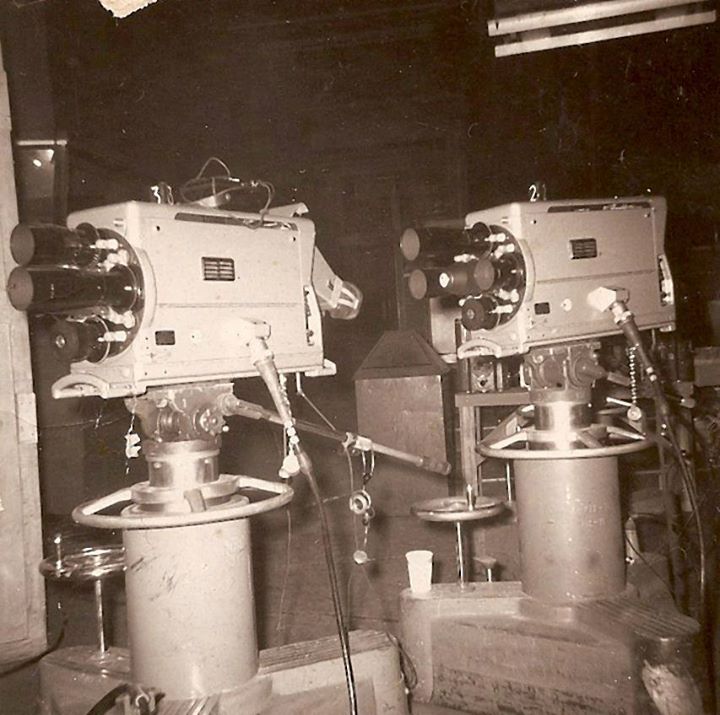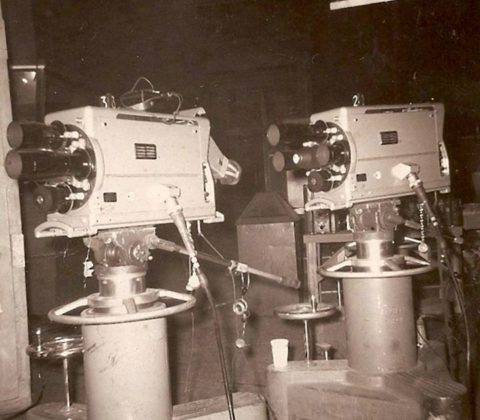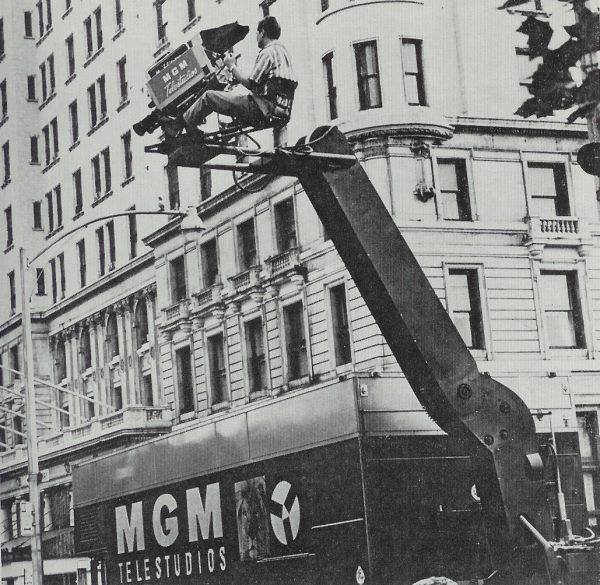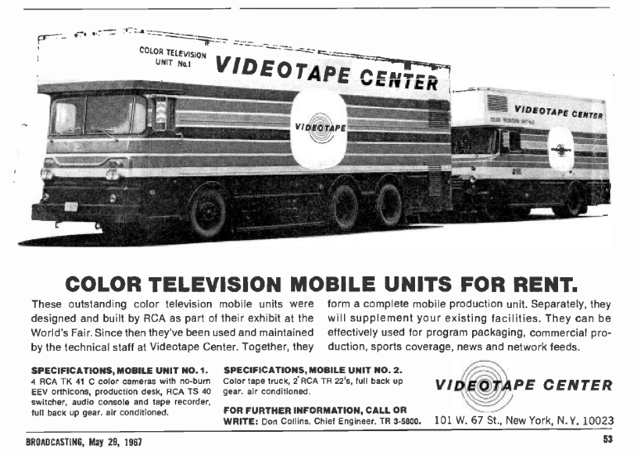

The History Of The Ampex Owned…Video Tape Center, Part 2 of 3
The History Of The Ampex Owned…Video Tape Center, Part 2 of 3
America’s First Commercial Television Production Facility
A few years ago, our friend Tom Coughlin traveled to Minnesota to comb the 3M archives as part of his ongoing research into the history of America’s first, and most innovative commercial tele production facility. Tom is a professor of journalism, but his deep interest here is also personal, as his dad was a longtime staff member at Videotape Center as well. This is part one of three fascinating instalments. Enjoy and share! Bobby Ellerbee
______________________________________________________
The 1962-1963 time period featured a busy schedule of TV commercials, a pilot for David Susskind (a series of one-hour adaptations of Broadway shows) that didn’t advance into series production, also production of Susskind’s “Open End” series for the 1963-4 season. For Sonny Fox Productions, Videotape Center recorded the TV adaptation of the off-Broadway show “Cowboy and the Tiger”, which aired on ABC in November 1963. Here is a clip of that show which was shot with Marconi Mark IV cameras. https://www.youtube.com/watch?v=hpZKrpuo8nM
In 1964, Videotape Productions demonstrated its “Edimation System”—a customized integration of Ampex’s “Editec” and “Edicomp” devices, which permitted time lapse video for the first time. These devices were demonstrated in advance of Ampex’s new product announcement. (“Broadcasting”, February 17, 1964, p 62)
In early 1964, Ampex Corporation left the partnership by selling their shares to 3-M, making it the sole owner. Howard S. Meighan, who was an Ampex board appointee and who also held a minority share of the company, took this opportunity to retire from the company presidency, and was replaced by Lanigan (“Broadcasting”, June 8 1964, p 10).
Business was no doubt adversely affected by the departure of Meighan, who was well connected to network executives and ad agency people, and after a year of poor revenues, 3-M concluded the 1965 calendar year, by reselling the shares formerly owned by Ampex, to M-G-M, which consolidated it’s New York City-based tape production house (M-G-M Telestudios) into Videotape Center using a shared assets agreement. Lanigan explained “it was a merger of two non-profitable companies, with the hope that one profitable company would emerge” (board minutes, July 1966). Joining the board as Vice President of the new company, was George K. Gould, the founder of Telestudios, who had lead the company through it’s acquisition by National Telefilm Associates, and then M-G-M in 1961 (“Broadcasting”, November 22, 1965, p 58).
The executive board for the new (post-1965) joint venture consisted of representatives from both 3-M Corporation and M-G-M. This was not a happy marriage–there were several management disagreements between the two groups of representatives. M-G-M’s people were quick to exploit loopholes in lease and labor contracts (which they did with RCA, AFTRA and the IBEW to save money). In addition, 3-M central corporate financial structure was such that they would absorb the bad, uncollectable debts of subsidiary companies—a feature that the M-G-M corporate directors took advantage of repeatedly, to the objections of the 3-M directors.
The joint assets operating plan of Fall 1965 was a blueprint to consolidate two companies’ large investment in soon-to-be obsolete black and white cameras, switchers, and low-band video tape machines. Telestudios was able to sublease their facility at 1481 Broadway (The Rialto Theater) to NBC, who used it to produce the soap opera, “The Doctors”. In 1966 they sold off their six TR-22 recorders (low band) and four of their six black and white RCA TK-60 cameras (the remaining two were leased to NBC for a time, and later used at Videotape Center for shooting titles and slates). In addition, they had four color RCA TK-41c cameras in the studio that were sold; and four Gemini film camera systems for which there was no resale market. The three black and white Marconi Mark IV cameras in Studio A (Ampex had been the US distributor for these English-built cameras) were considered unsalable— 3-M contemplated donating them to a university as a tax write-off. Studios B and C had 1950s-era RCA camera chains owned by RKO (from the early 1950s when WOR operated the studio) which were included the original facility lease from 1961, which were obsolete by that time, and didn’t actually belong to either Videotape Center or M-G-M.
To provide color recording capability at Videotape Center with the lowest possible initial investment (they were concerned about getting the new company heavily invested in color equipment at a time when the technology was rapidly improving), several months prior to the start of the joint operating agreement, M-G-M Telestudios signed a five year lease (November 1964 to November 1969) from RCA for three used TK-41c cameras and two TR-22 recorders, to which 3-M was cosigner and guarantor, to upgrade the Leo remote camera truck and the associated videotape truck to color. After the start of the joint venture, Videotape Center contributed an additional fourth TK-41c to the truck that had been used in the studio for evaluation and chroma key use. (Other than this one camera chain, Videotape Center was a black and white TV studio until Spring 1967.) The ownership of the Leo remote truck and the tape truck (including the TV cameras and video tape machines installed on it) was kept separate from the rest of the Videotape Center joint venture to take advantage of M-G-M’s pre-existing lease agreement with RCA, as well as a pre-existing labor contract with the IBEW that offered more favorable labor costs for the remote truck technicians.
In addition, the joint venture wished to retain 3-M’s more-favorable studio employee contracts with DGA, AFTRA, and IATSE. While the joint venture (which continued to do business under the name Videotape Center—M-G-M’s Leo remote truck was repainted), there were two separate teams of IBEW-represented employees working on the truck and working in the studio with different pay schedules and seniority lists. Between 1966 and 1969, both AFTRA and IBEW had staged strikes at Videotape Center to protest this corporate slight-of-hand, which they viewed as unfair labor practice. (The labor problems at Videotape Center resulted in an ongoing disagreement between 3-M and M-G-M corporate directors, and contributed in no small way to 3-M’s eventual decision to liquidate the joint venture.)
By all accounts the Leo truck was pretty busy. ABC rented it from January to May 1966 (and while doing so, offered to buy it), and CBS rented it for $2,500 a week between September and December 1966. In addition, CBS frequently rented the videotape truck (which contained two RCA TR-22 video recorders) for stand-alone use.
The Videotape Center engineering department was never entirely pleased with the performance of the used RCA TK-41c cameras—they produced noisy pictures compared to plumbicon cameras, and while they were acceptable for TV show origination, they were not up-to-date enough for TV commercial work. Videotape Center’s upgrade plans from 1965 included decommissioning Studio C, and purchasing eight cameras, four each for Studio A and B. (The upgrade plans called for getting six cameras in early 1967, and an additional two in 1968) and they had evaluated the Marconi Mark VII, Norelco PC-70 and RCA TK-42 cameras before deciding to go with Norelecos.
The main reason they chose to buy eight Norelco plumbicon cameras over the other makes was the price: Norelco PC-70s were selling at $65,000 while the Marconi Mark VII and TK-42 were both $80,000. In addition, Norelco was willing to give Videotape a delivery date for six cameras in Spring 1967, while Marconi wouldn’t be able to deliver until Fall 1967.
There were technical considerations too. Comparing the Norelco PC-70 color picture to that of the TK-41c, the picture quality was softer and more pastel-like, though the 41c rendered red shades more accurately. The TK-41c had a tendency toward grainy, noisy pictures. Advertising agency clients had a strong preference toward Norelcos, however the engineers could tune the TK-41c to look pretty close to the output of a PC-70 using a newly-introduced set of I.O. tubes that English Electric Valve had developed. RCA’s replacement model, the TK-42 suffered from poor picture quality, but the salespeople promised that the images would improve when ‘Selenicon’ image pick-up tubes became available.
Between 1965 and 1967, The Leo truck was used at Videotape Center for most color productions. As Videotape Center had color recording capability in their tape room, they needed only the Leo truck (and not the tape truck) to shoot. For productions where color was critical and clients were fussy, their main backup provider was Reeves, who was a major rental house of video equipment at the time. Reeves had Norelco cameras, along with switchers, and support equipment in transportable pods that would be delivered to a studio for a video shoot. For most of their customers, Reeves used telephone company circuits to get the video signal back to Reeves’ production center at 304 East 44th St., where they had a bank of high-band color recorders. Most of the time at Videotape Center, the feed from the Reeves equipment was routed to Videotape Center’s in-house tape room, which had been upgraded to high-band color in May 1966 when they traded in their six Ampex 1000c machines for six Ampex 2000 machines. (The Videotape Center tape room was always busy with color post-production work, and ran 24-hour days to keep up editing and tape duplication orders).
According to an ad in Broadcasting Magazine (October 7, 1968, p 3) another provider of color truck services was RME (Richard Mann Enterprises, of Columbus OH, another Norelco truck operator). In addition, through arrangements lost to the passage of time, Videotape Center was the custodian of RCA’s Worlds Fair remote color unit, which comprised two trucks and featured four RCA TK-41c cameras, and two TR-22 recorders. An ad in Broadcasting Magazine (May 29, 1967, p 53) states that the truck was “used and maintained by Videotape Center” and is available for rent through Videotape Center’s engineering department. For the photo in the ad, Videotape Center logos were airbrushed over the RCA meatballs on the side


Cue Artie Johnson, “Very Interesting”. It’s because of an independent company like that there is a videotape of 3/4 of the first Super Bowl out there. It’s in legal limbo as they haggle endlessly over the price and ownership, but it’s out there.
It always makes me feel grounded, stable when you post a technological (nerdy, geek) article. Love you, hug the boss❤️
Wow great history, I cut my teeth in the biz @ the RCA Pavillion at the world’s fair. Once the fair closed, helped install the TC41’s into Leo then went to work at Reeves went on remotes with the Norelco cameras. Memories Thanks so much for the excellent article.
Thanks for the post!
These are the Videotape Center’s RCA TK41s.
This is the Gemini Video-Film system mentioned in the article. It allows dual recording capabilities through the camera lens to film and videotape.